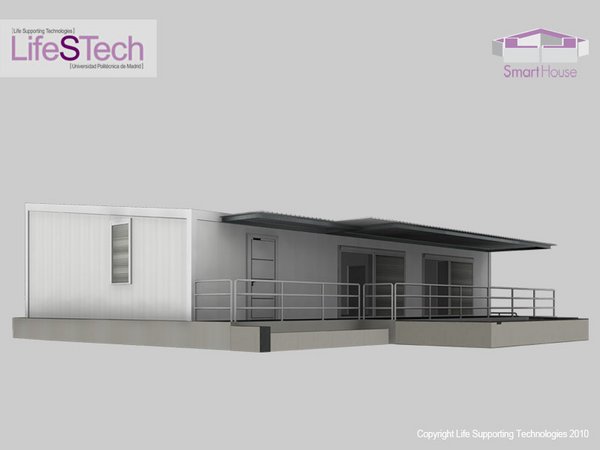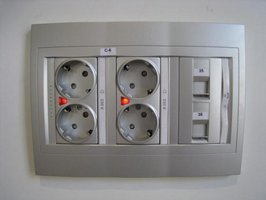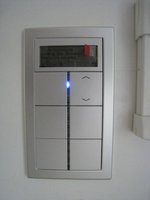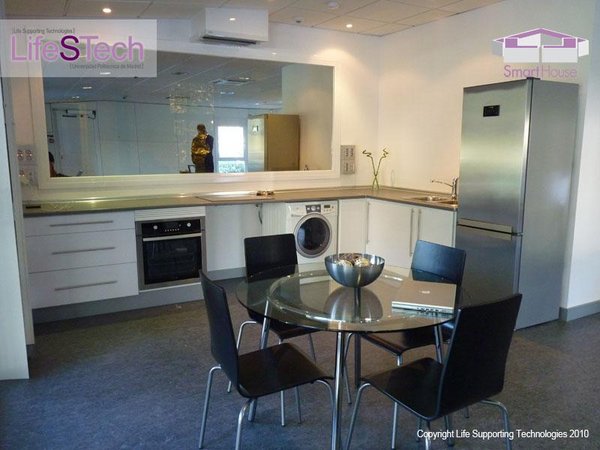Living Lab and Technical Infrastructure
Living Lab and Technical Infrastructure of indoor localization and tracking
he Smart House Living Lab is located at the Escuela Técnica Superior de Ingenieros de Telecomunicación of the Universidad Politecnica de Madrid (ETSIT UPM), in Madrid, Spain.

The complete address is:
Escuela Técnica Superior de Ingenieros de Telecomunicación (ETSIT)
Avenida Complutense nº 30
Universidad Politécnica de Madrid (UPM)
Ciudad Universitaria s/n
28040 Madrid
GPS: 40.45236386045641,-3.7273263931274414
You can see the area and the maps on Google Maps, all the area is mapped and fotographed.
For logistic information please download this file. Do you need to buy last minute components and cables? We have created a list of electronic components shops reachable from our lab.
The localizable area is identified by the grey area of the figure above.
Infrastructure
Rooms:
- Control room with unidirectional vision glass to observe the common space
- 3D immersive room
- Bathroom
- Porch with ceiling outside the common space and control room. With garden and pool with fish and waterfall type fountain
- Common space that includes:
- Kitchen
- Living room
- Bedroom
Only bathroom, common space and the porch will be localizable.
The actual localizable space and its reference coordinates can be downloaded here.
Ceiling, floor and walls
- Drop ceiling
- Floor with distributed hidden "holes" with plugs
- Detachable wall modules
Ceiling has not a fixed height.
The lowest part, where the porch and the entrance are, is 2.32m high.
From the porch to the first girder the ceiling will be inclined until reaching the height of 2,62 meters.
From that point on the ceiling is 2.62m high.
The transversal diagram of the structure is visible here.
The best option for fixing appliances to celinig and walls is blue tack.
We have also successfully used adhesive velcro in other occasions.
In case, it is necessary, the tiles of the ceiling can be lifted. Tiles are 57 cm x 57 each.
Communication
- Ethernet sockets
- WIFI
- High speed internet connection
Competitors will have to send their localization samples through the Wi-Fi or the Ethernet connection.
Sensors and actuators connected through KNX
- 2 Flood sensor (in kitchen and bathroom)
- 1 Smoke sensor (next to the kitchen)
- 1 Fire sensor (next to the kitchen)
- 6 Blinds actuator (in bedroom, entrance/living room and kitchen)
- 4 Doors actuator (entrance, bathroom, living room and kitchen)
- 2 Light sensor (in bedroom and living room)
- 1 Alarm detection pull cord (in bathroom)
- 4 Motion sensor (in entrance, living room, bedroom and bathroom)
- 6 Magnetic contact sensor (in entrance door, living room door, bathroom door, kitchen door, bedroom window and bathroom window)
- 2 HVAC systems (in ceiling)
Competitor will receive contextual events coming from the light switches and a stationary bike (which is NOT KNX). The coordinates of these appliances is published here.
Other equipment
- 1 movable IP PTZ camera
- 5 Environmental microphones
- 10 Ceiling speakers
- 3 Active RFID readers pluggable to Ethernet sockets
- Electronic stationary bicycle with embedded computer and actvity monitor.
Computing
- 4 Panel PCs
- 1 Server for automation purposes
Software
- Loquendo ASR Voice recognition software (English and Spanish)
- Loquendo TTS voices (English and Spanish)
- Prosyst OSGI Smart Home SDK
Household appliances
- Home appliances (Fridge, oven, cook and washing machine automated with Maior-Domo® by Fagor).
- 37 inches flat television
- Sony's Aibo personal entertainment robot dog



Integration with the benchmarking system
Competitors are kindly requested to perform a simple SW integration with our benchmarking system.
For this purpose, we have created an "integration package" with a developer's handbook.
The package allows sending localization samples and receiving events from the domotic bus.
Roughly, each localization sample is identified by:
- timestamp of event (as estimated by the localization system, can be different from the current one)
- coordinates of the localized subject
- Areas of Interest the subject is located in (it can be more than one)
Our system is based on the universAAL middleware, and, although it is possible to deepen inside the details of the platform, we have abstracted all the middleware and created a simplified interface for the competition.
The package allows two options:
- a java interface which will be used by the middleware to send samples
- sending data to a local socket while an instance of the middleware is running and listening to it. This solution allows systems which are not based on java to run in any case.
All the instructions and details about the integration package are contained in this manual.
Time Synchronization
Since the evaluation tool will rely on competitor's machine for time stamping the localization packets, the two computers (the one with the ground truth position/timestamps and the competitor's one) must be synchronized.
The competitors MUST come with a NTP client installed on his computer and they MUST run it before starting the benchmark. The organizer will verify that the clock of the two computers are actually synchronised.


